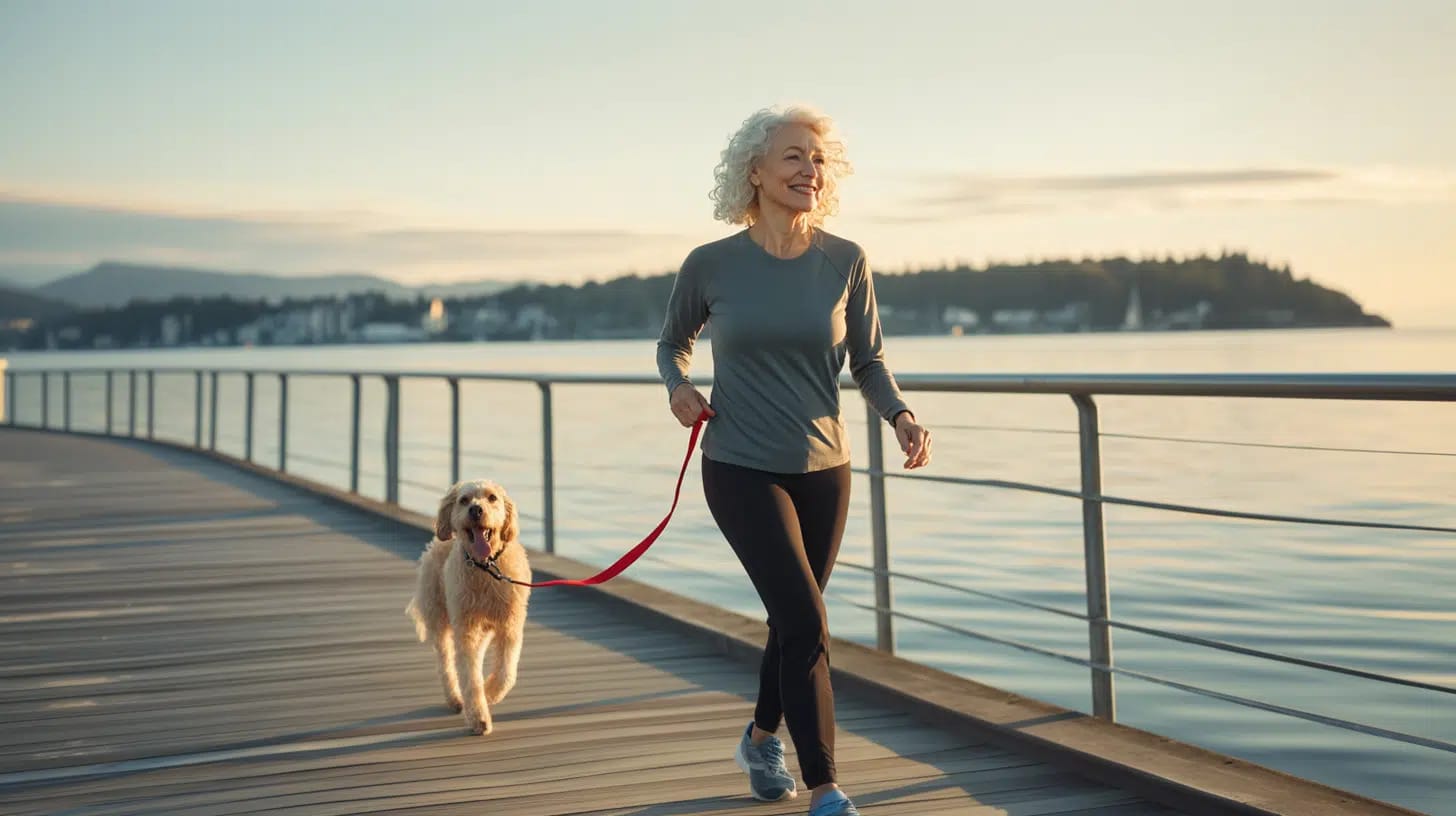Exercise and physical activity are vital in maintaining overall health and well-being for older adults, particularly in today’s fast-paced world. As we age, staying active becomes increasingly important for supporting weight management and preserving independence. Regular exercise provides many benefits, including increased longevity, improved functional mobility, and enhanced mental health. Older adults who participate in physical activity can strengthen their bodies, boost their mood, and maintain a healthier weight.
Many exercise options, such as aerobic workouts, strength training, flexibility exercises, and balance routines, are tailored to older adults. These activities can be adapted to individual abilities and preferences, promoting safety and consistency. Structured programs and low-impact approaches like aquatic exercises benefit joint health and comfort. By making physical activity a routine, older adults can enjoy a more active, independent, and fulfilling lifestyle.

Benefits of Exercise for Older Adults
Exercise is vital to maintaining health and well-being as we age. Physical activity provides numerous benefits for older adults, including improved longevity, functional independence, and mental health. Regular exercise can help manage weight, reduce the risk of chronic diseases, and improve overall quality of life, making it essential for older adults. By incorporating aerobic exercises, strength training, and flexibility activities, seniors can enjoy an active, healthier lifestyle and maintain their independence longer.

Increased Longevity
Older adults who exercise regularly often experience increased longevity and a better quality of life. Studies show that aerobic fitness reduces the risk of all-cause mortality, even in those beginning exercises at an older age. Frequent physical activity lowers the chances of developing chronic diseases like heart disease and diabetes, thus extending life expectancy. Endurance and strength training improve cardiovascular function and help maintain muscle mass, both essential for a long, healthy life. Regular exercise decreases the likelihood of mobility limitations, allowing older adults to live actively for more years.
Improved Functional Independence
Functional independence is crucial for older adults, and regular physical activity plays a significant role in preserving it. Exercise helps counteract muscle loss, which is essential for strength and mobility. Strength training is vital in maintaining independence by boosting muscle mass and strength. Physical activity also enhances bone health, reducing osteoporosis risks and preventing fractures. Regular exercise improves postural stability, lowering the risk of falls and supporting sustained independence. Increased flexibility and range of motion further assist in maintaining mobility and reducing injury risks.
Enhanced Mental Health
Exercise offers significant mental health benefits for older adults. Regular physical activity is associated with reduced depressive symptoms and better overall mental health. Engaging in exercises such as exergaming can improve mood and self-esteem and alleviate anxiety. Activities done with others can reduce feelings of loneliness, bolstered by the mood-enhancing release of endorphins during exercise. Both resistance and aerobic exercises are effective in reducing anxiety and depression among older adults. These mental health benefits are particularly pronounced in older individuals facing cognitive impairment and late-life depression, showcasing exercise as a powerful intervention strategy.

Types of Exercises
Regular exercise is vital for older adults to maintain health and vitality. Various types of exercises can help improve overall fitness and well-being. These exercises fall into three main categories: aerobic, muscle-strengthening, and balance and flexibility. Each type has specific benefits and is crucial in supporting weight loss management, enhancing physical performance, and improving quality of life. By incorporating these exercises into their routines, older adults can achieve significant health benefits, such as better functional capacity, reduced risk of chronic diseases, and improved mental health. Let’s delve deeper into each exercise type and explore how they contribute to an active, healthier lifestyle.
Aerobic Exercises
Aerobic exercises are essential for older adults, helping to keep the heart healthy and improve breathing. Activities like brisk walking, water aerobics, and cycling raise the heart rate and make you breathe harder. Engaging in moderate-intensity aerobic activities for at least 150 minutes a week is recommended to reap the health benefits. Alternatively, vigorous-intensity exercises can be done 75 minutes weekly for similar advantages. Aerobic activities enhance balance and independence and lower the risk of falls. By engaging in these activities, older adults can prevent chronic conditions such as heart disease, osteoporosis, and type 2 diabetes. Swimming and dance classes can significantly improve quality of life and reduce the risk of premature death.
Muscle-Strengthening Exercises
Muscle-strengthening exercises are vital for older adults and should be performed at least twice a week, targeting all major muscle groups. Lifting weights, using resistance bands, and doing push-ups help build and maintain muscle mass. These exercises should be done until a short rest is needed before repeating them. Everyday tasks like carrying groceries and gardening can also strengthen muscles. Older adults must include these exercises in their routines, separate from aerobic activities. Doing so ensures comprehensive physical fitness and helps you perform daily activities quickly and confidently.
Balance and Flexibility Exercises
Balance and flexibility exercises are key to preventing falls and maintaining mobility for older adults. Balance exercises, including walking backward or sideways and heel and toe walking, should be practiced at least three times a week. Gradually increasing the difficulty of these exercises challenges the body’s coordination. In addition, stretching activities are crucial and should be done for at least 10 minutes a day, twice a week, to maintain flexibility. Pilates training can improve balance, strength, and functionality. Yoga and tai chi also enhance balance, flexibility, and strength. Incorporating these exercises into regular routines can enhance stability and promote an active lifestyle.

Promoting an Active Lifestyle
Promoting an active lifestyle among older adults is vital for improving overall health and well-being. Regular physical activity is essential for maintaining a healthy body weight and reducing the risk of chronic diseases. By incorporating exercise into daily routines, older adults can experience enhanced quality of life and increased functional capacity. Engaging in physical activities can also help manage existing medical conditions and lower the risk of falls. With various exercise routines to suit different abilities and preferences, older adults can find enjoyable ways to stay active and healthy.
Structured Programs
Structured physical activity programs are key to unlocking numerous health benefits for older adults. These programs empower seniors by encouraging regular exercise through well-planned activities. Support from federal funding sources makes these programs more accessible, ensuring seniors can easily participate. Programs meeting specific criteria offer targeted relief, such as Arthritis-Appropriate Evidence-Based Interventions that have proven effective in reducing arthritis symptoms. When age-friendly programs are tailored to local community needs, they significantly enhance seniors’ health and life satisfaction. By participating in these structured activities, older individuals can see improved life expectancy and reduced disease risk factors.
Aquatic Exercises for Joint Health
Aquatic exercises are an excellent option for older adults seeking to improve joint health and overall fitness. The buoyancy of water provides support, easing the stress on painful joints and making exercise more comfortable. Programs designed specifically for people with arthritis, such as the AEA Arthritis Foundation Aquatic Program, use warm water to help relieve pain and stiffness while boosting mobility. Activities like water aerobics and swimming promote joint health and enhance balance. Water’s natural resistance offers a safe, low-impact workout, ideal for maintaining or improving muscle strength and flexibility. With these benefits, aquatic exercises are a secure choice for older adults, particularly those concerned about stability.
Take the First Step Toward a Healthier Future
Exercise and physical activity are essential for older adults to maintain strength, independence, and overall well-being. By staying active, seniors can better manage their weight, reduce the risk of chronic conditions, and enjoy a more vibrant life. Whether it’s through aerobic workouts, strength training, or joint-friendly aquatic exercises, there’s a routine for every fitness level. To get started on a personalized plan, contact Regner Health Solutions at (952) 900-3994 and schedule your weight loss consultation today.






